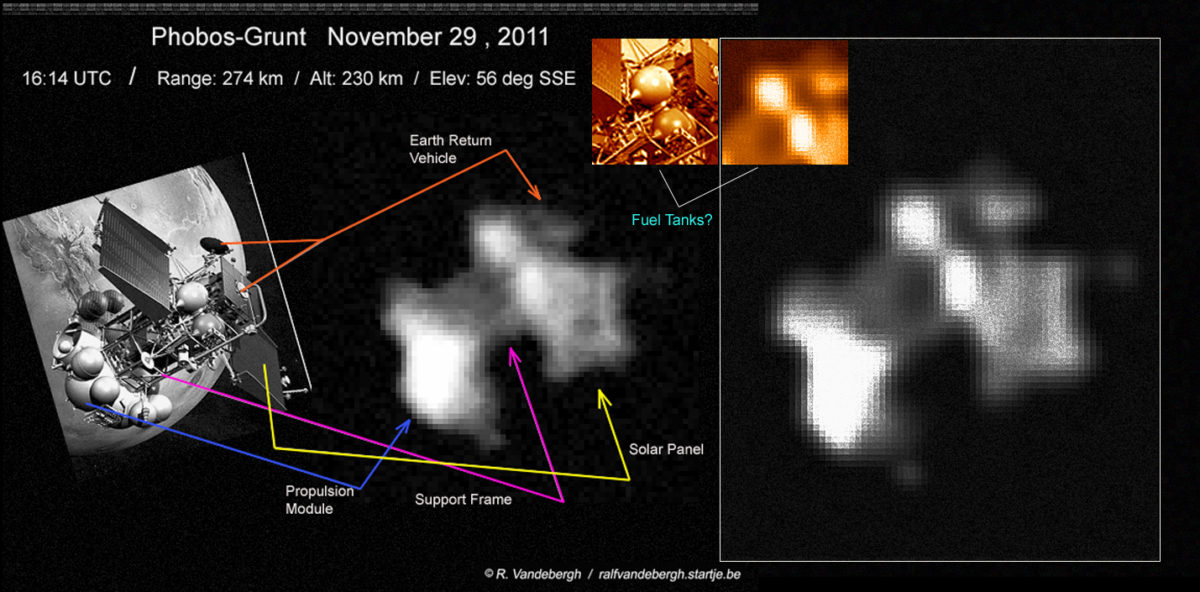Louis D. Friedman • Feb 06, 2012
Phobos-Grunt Failure Report Released
Back when the U.S. suffered several Mars mission failures, we indulged in some dark humor at JPL, blaming the "great galactic ghoul" for gobbling up our spacecraft. For a while, after the failure of Phobos-Grunt, it appeared that some in Russia were taking the blame-game seriously and grasping at improbable external causes for the loss of the spacecraft.
But it appears that Phobos-Grunt was doomed before it launched on November 9, 2011. Cheap parts, design shortcomings, and lack of pre-flight testing ensured that the spacecraft would never fulfill its goals. Its troubles became apparent a few hours after its launch, when it failed to fire thrusters to take it out of Earth orbit and on its way to Mars and its moon Phobos. It fell back to Earth on January 15.
Between launch and re-entry, a flurry of excuses were floated both within and without Russia. News media quoted Russian space official blaming beamed power from an American radar station, radiation from a solar storm, and counterfeit electronic chips from an unnamed foreign supplier.
Thankfully, this obfuscation turned out to be noise, and the actual failure report issued last week by the Russian space agency (Roscosmos) makes it clear that the fault lies at home -- due to non-space qualified parts being used in some of the electronics circuits. This is a design failure by the spacecraft engineers that might have been caught had they performed adequate component and system testing prior to flight. But they did not.
The officially released final report presents three main conclusions (paraphrased here from a cursory and unofficial translation):
The Phobos-Grunt failure emphasizes the unforgiving nature of space exploration, where cutting corners in the spacecraft development, especially in testing, can be fatal. Other errors on the mission included the system being designed so that the spacecraft was out of communications range after launch, so mission personnel had no idea how it was behaving. In this, the Russians repeated the error that doomed their Mars-96 mission.
For Planetary Society Members, with the failure of Phobos-Grunt, we lost Phobos LIFE -- our Living Interplanetary Flight Experiment. The Russian scientists and engineers lost years of work. The Chinese lost their first interplanetary spacecraft -- an intended Mars orbiter that was piggybacking on the Russian spacecraft.
Planetary Society Members share in both the triumphs and defeats in space exploration. We remain grateful for the opportunity to truly participate in great missions of discovery, and we are determined to keep exploring. The loyal support of Society Members is the only thing that makes it possible to attempt great things. We remember that, after Mars Polar Lander crashed carrying our Mars Microphone, we returned to Mars with the Spirit and Opportunity rovers. After Mars-96 took our Visions of Mars library to the bottom of the ocean, we flew it again on Phoenix. We know there will be more chances to return to the Red Planet.
What's next in Mars exploration? Scientists in Russia would like to try another Phobos-Grunt mission. But this would be expensive and is likely not possible before 2020. To overcome the system failures made blatant by this latest failure would require significant changes in the Russian space industry. On the table, however, is a nearer-term and easier-to-implement proposal: the Russians could launch the European Space Agency's Mars Trace Gas Orbiter in 2016 and the ExoMars rover in 2018. In return for launches, the Russians would share in the missions' science. The Russian and European space agencies are now considering the possibilities. Sadly, the U.S. was supposed to be a partner in the 2016/2018 Mars missions, but it appears that the NASA budget to be released next week will kill that plan. Indeed, the future of NASA's Mars program may be at risk. Stay tuned.
Lou Friedman, former Executive Director of The Planetary Society, served as Principal Investigator on the Phobos LIFE experiment on the Phobos-Grunt mission.

Support our core enterprises
Your support powers our mission to explore worlds, find life, and defend Earth. You make all the difference when you make a gift. Give today!
Donate

 Explore Worlds
Explore Worlds Find Life
Find Life Defend Earth
Defend Earth

